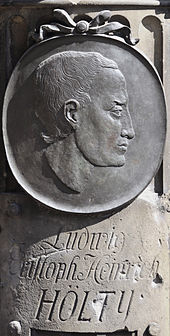Hölty Monument (Hanover)

The Hölty monument in Hanover was created at the beginning of the 20th century by the architect Otto Lüer and the sculptor Karl Gundelach . The memorial was erected in the old St. Nikolai cemetery instead of a grave of the "spring poet" that could no longer be found at the time of the Electorate of Hanover and has been changed several times over the years.
history

Ludwig Hölty , "because of his poetry famous", after his death in 1776 for "18 Gutegroschen [... a temporary] funeral on corruption given". He was buried on September 4, 1776 in the Nikolaifriedhof, which at the time was in front of the Steintor outside the old town of Hanover.
Whether a tombstone was placed on Hölty's grave has been a matter of dispute for centuries. Hölty's friend Johann Heinrich Voss wrote in the foreword to the volume of poetry published just a few years after Hölty's death in 1783: “A memorial cannot be placed on him, but in Hanover, where Leibniz is also buried, it is no sign of disdain that one does not know the place of the buried ” . However, this was contradicted by a different statement by Field Provost Reinecke , who had worked as a collaborator on the old garrison church from 1822 , that he had still seen Hölty's tombstone.
In any case, Hölty's grave mound - as well as a possible gravestone - had been removed after the deadline. Half a century after the burial, the artist Rudolf Wiegmann created a lithograph of the Nikolaifriedhof with a view of a busy scene, seen from outside the cemetery wall from the Goseriede .
It was not until the end of the 19th century that the “ Heimatfreunde ” and the public reawakened interest in the creation of a memorial for the poet who died young. The foundation stone for the Hölty memorial was therefore laid on December 21, 1898 . However, the monument was not completed until three years later and was unveiled on June 12, 1901.
In the middle of World War II , the Hanoverian photographer Wilhelm Hauschild took several photographs of the monument in 1942. The base of the monument and its superstructures, which is still preserved today, can be seen on it, but also a semicircular walling around the monument, at both ends of which two generously framed stone benches invited to linger in front of an ornamental grille. The attached at the monument portrait - medallion showed a young man with a backwards held together by a loop braid in the style of the 18th century.
Apparently, however, the portrait medallion was lost, so that a new portrait of Hölty, changed in appearance and hairstyle, was attached by the sculptor Adolf Sötebier .
However, the inscriptions on the sandstone plinth of the monument have been preserved, including a verse by Nikolaus Lenau :
“Hölty, your friend, spring has come. He is wistfully wrong to find you. But in vain, his plaintive reputation fades into lonely shadows. "
See also
literature
- Helmut Plath : The Nikolaifriedhof. Lithograph by Rudolf Wiegmann (subtitle to explain the picture opposite), in: Hanover in the image of the centuries , 3rd, expanded and improved edition, Madsack, Hanover 1966, p. 70
- Helmut Knocke , Hugo Thielen : Goseriede. In: Hannover Art and Culture Lexicon , p. 124f.
- Hugo Thielen: Hölty, Ludwig Christoph Heinrich. In: Klaus Mlynek, Waldemar R. Röhrbein (eds.) U. a .: City Lexicon Hanover . From the beginning to the present. Schlütersche, Hannover 2009, ISBN 978-3-89993-662-9 , p. 303.
Web links
- Wilhelm Hauschild (photographer): Hölty monument, 1942 on the hannover.de website , last accessed on November 11, 2014
- Olaf Pytalhost: Public Art in Hanover / Hölty Monument , commented on the photo gallery on his page olaf.pytalhost.com
Individual evidence
- ↑ a b c Hugo Thielen: Hölty, Ludwig ...
- ↑ a b c d e Helmut Plath: The Nikolaifriedhof ... (see literature)
- ↑ a b c Compare Wilhelm Hauschild (photographer): Hölty-Denkmal, 1942 (see under the section web links ) as well as the photo next to Hugo Thielen: Hölty, Ludwig ... (see literature)
- ↑ a b Compare the documentation at Commons
Coordinates: 52 ° 22 ′ 42 " N , 9 ° 43 ′ 55.7" E
